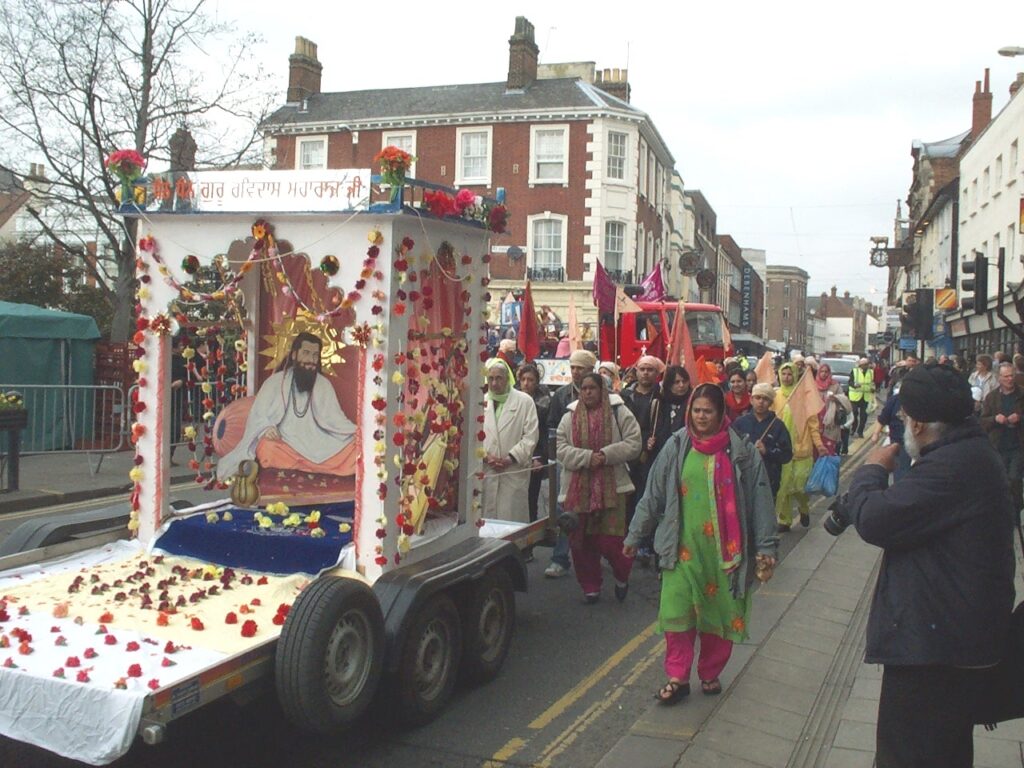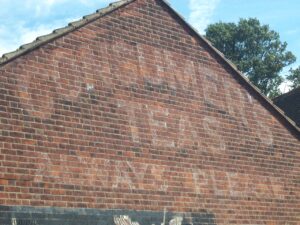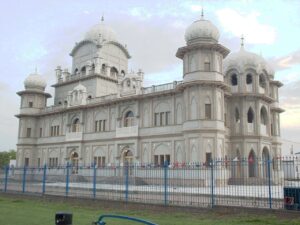Casey A’Hearn completed their MA in Religion in Culture from the department in May 2024 and will be starting their PhD at Princeton in August 2024.

In 2008, a group of Ravidassia practitioners held a parade in Bedford, England to celebrate the birthday of Guru Ravidas. It was this image taken by Mr. Simon Speed that caught my attention. I am not a scholar of Ravidassia, nor am I particularly familiar with their traditions. But I have learned that they follow a guru from India named Ravidas, identify mostly with the region of Punjab and have a complicated relationship with Sikhism. Additionally, I think I can conceptualize what a ‘birthday’ is and why it would be important to celebrate it for Guru Ravidas. But is Guru Ravidas English?
One way to make sense of my posited question is to turn to the social theorist Jean-François Bayart. In The Illusion of Cultural Identity, Bayart writes, “In studying a concrete society, we discern a plurality of cultural repertoires.” When I looked at the initial picture, all I could see was the conglomeration of these cultural repertoires. The sky is muddled to signify a gloomy English day, in the background – an English building in the style of a 1930’s Semi. The people walking in the parade are carrying Ravidassia flags wearing thicker fall jackets. Parade-onlookers are taking photos and chatting on the side, also dressed for chilly English weather. The parade-walker in the front wears her pink dupatta and a dress of beautifully vibrant green. Most apparent are the wheels of the parade float, visible and industrial, juxtaposed to the carefully arranged petals at the feet of the Guru. It is within this image that we truly understand how a “concrete society” is divided into a “plurality of cultural repertoires.”
But why do I see society as a homogenized thing rather than a group of cultural repertoires? When I looked at the photo initially, I wasn’t sure Bayart was right. Was I seeing one concrete society or the plurality? I had to ask myself: Did the image fit with my own cultural caricature of England? Why or why not? Admittedly, there are a few answers to this question – but I want to focus on one: Identity Construction.

When I thought of England, I had several of images come to mind. I first thought of the English flag, but that image quickly shifted to various members of the royal family. Unconsciously, though not very, that thought led me to conjure up images involving a map of their colonial Empire. Then I thought, “What about tea?” I wondered to myself if anyone else thinks of England like this old, faded advertisement that reads, “Consumer’s Teas Always Please”? What I came to examine within my own introspection was this: Depending on my answers to questions like these, I can begin to illustrate that the image of England I create is entirely influenced by the incorporation of my own values, beliefs, histories, and experiences projected onto England.

This is the core concept of societal homogeneity that I want to interrupt: My illustrations of other countries and peoples have as much to do with my own perception as it does with the country’s own identity. These assumptions I adopt can function as tools to create boundaries between my own country/culture/self and a constructed ‘other’. It works vice versa. Before looking through Mr. Speed’s photos, I would not have expected to see this image of a Gurdwara. It sits at the end of Ford End Road in Bedford, Bedfordshire. Its presence disrupts my own preconceived notions of the social homogeneity of England.
Mr. Simon Speed takes a lot of photos of Bedford, England. When I looked through these photos, I noticed that there are a plethora of things pictured: museum artifacts, houses, parades, people, even preserved bug specimens! Examining images like these helps me better understand all the competing things that go into constructing identity and even more so that go into constructing an identity as homogenous. If these images in Mr. Speed’s collection could be considered an archive of Bedford, England, they would work together to both disrupt and reinforce stereotypes of English identity. At the same time, the pictures themselves are all moments in which the repertories of culture are made apparent to us as scholars. These ideas do not stop at Bedford, England either. Our own assumptions about places and peoples permeate throughout our collective societies. Is Guru Ravidas English? Are any of these images I have curated inherently English? As scholars, we can begin to understand how our own caricatures of the societies we study are built and maintained through our own interactions with them.
Photo credits: All by Simon Speed, accessed through Wikimedia Commons, Public Domain
Featured photo: A procession in Bedford